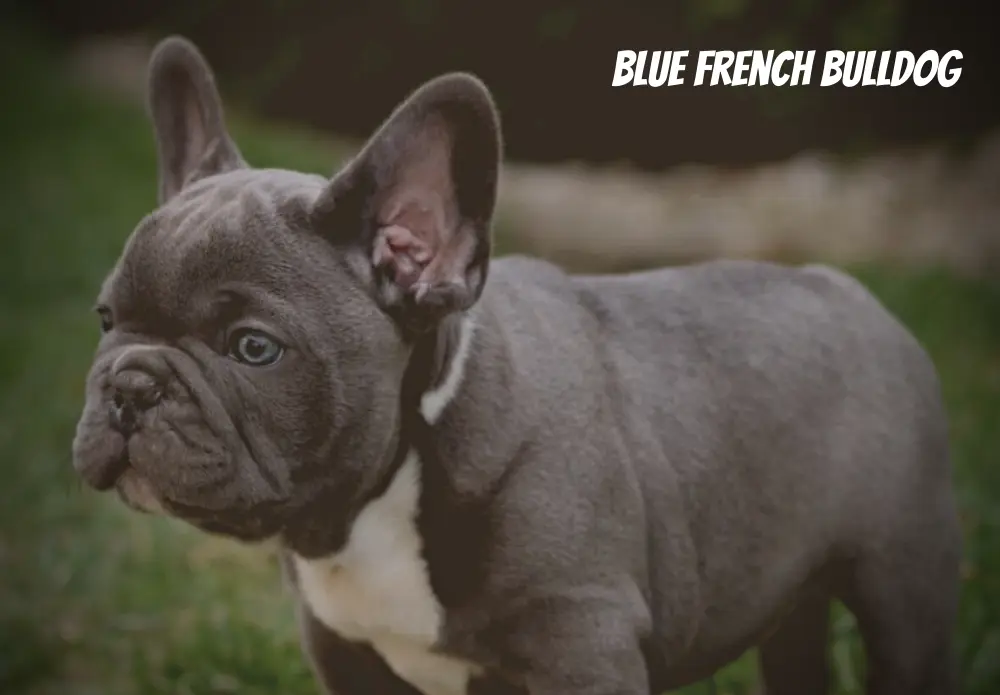Blue French Bulldogs are rare Frenchies with a shiny blue color on their coat. It is a rare color and a very expensive one. They are stocky but small, with loose skin and mushed faces that look so cute with their iconic bat ears.
Blue Frenchies come in solid blue or other combinations, which we will discuss in this article.
What is a Blue French Bulldog?
A Blue French Bulldog is not a blue but silver gray that looks blue. A recessive gene causes the blue shade in French Bulldogs in their DNA. Both parents must pass down one copy of this gene to produce a Blue Frenchy.
Since the Bluecoat is a result of a recessive gene, it is associated with health issues, which is why the AKC does not recognize this color. Many breeders will breed these puppies solely for profit purposes and completely ignore the health risks it carries.
Characteristics of Blue French Bulldog
Looking at the Blue Frenchie from a distance, you will think it is a blue dog. It is when you take a closer and more detailed look and notice the silver-grey color.
Blue French Bulldog appears to be an active muscular dog with heavy bones, a smooth coat, and a medium or small size that is compactly built. The cute puppy has an expression of alertness and curiosity and is always interested.
The back is bent with a slight fall close after the shoulders; short and strong, broad at the shoulders and contracting at the loins. The body is short and well-rounded. The chest is deep, wide, and full, well ribbed with the belly tucked up.
The tail is often straight or sometimes screwed (but not curly), short, hung low, deep root and fine tip, carried low in repose. Any modification other than the removal of dewclaws is considered mutilation and unnatural.
1. Size and Weight of Blue French Bulldog
The male Blue French Bulldogs usually grow from 10 inches (27 cm) to 13.7 inches (35 cm), whereas the females grow from 9 inches (24 cm) to 12 inches (32 cm).
The Frenchie males weigh 20 to 30 pounds, and the females weigh 17 to 28.
2. Coat and Color of Blue French Bulldog
As I have mentioned above, the color of the Blue Frenchie is affected by the recessive gene that causes the black coat to appear shiny blue, but in reality, it is silver-grey.
Blue French Bulldogs come in four main colors and markings depending on the parent dogs: blue merle, blue pied, blue fawn, and blue brindle.
Merle Blue Frenchies
Blue Merle is considered the most attractive color but the most difficult to breed. It requires mating a Merle Frenchie with a blue Frenchie. The result is a coat with patches of blue color from the dominant merle gene and leaves the rest of the coat the original color. The pattern on each dog varies in size, shape, and location on the coat.
Blue Pied
The Blue Pied coloring is easy to breed but difficult to predict the pattern. It requires mating a pied Frenchie with a blue Frenchie. The coat color will mix fawn, cream, and brindle, with lighter coloring on the chest area, cheeks, and legs.
Blue Brindle
Brindle Blue has an obvious blue/grey coat color with brindle or tiger markings.
Blue Fawn
Blue Fawn carries the double recessive dilution gene of the blue and pied colors and 2 additional genes giving the fawn color. The darker blue color has a brindle gene, too, which can be seen around their eyes, ears, muzzle, and back. This unusual color blend makes it one of the most popular for Frenchie owners.
French Bulldog’s coat shed quite a bit despite being smooth and short. It is because they have recessive genes that can affect their overall health and body.
4. Head and Facial Features of Blue French Bulldog
The Blue Frenchies have a large square head. The eyes of French Bulldogs are wide apart, set lower in the skull, far from the ears, round in form, moderate size, neither sunken nor bulging.
The head is muscular, has extra skin, and appears to be staring into your soul.
When the mouth is closed, a thick and broad upper jaw hangs over the lower jaw on the sides, meeting the underlip in front and covering the teeth that are not visible when the mouth is closed.
The underjaw is large, deep, square, undershot, and well-turned up. The neck is thick and well-arched, with loose skin at the throat.
5. Personality and Temperament of Blue French Bulldog
The Blue Frenchie is an easy-going, good-natured, friendly little dog that loves company. A good companion dog that is suited to apartment and city living as they are not particularly active and don’t bark much.
The Blue French Bulldogs are less aggressive than regular Frenchies. I do not mean that other Frenchies are aggressive; what I mean is that these Blue puppies are far less aggressive.
Because the recessive genes make them less aggressive and violent, many would say the “disadvantage” of Blue Frenchies is their plus point.
Their calm demeanor makes them the perfect family dog that does well with children and other pets. Thanks to their Bulldogs ancestry, Blue puppies have a high intelligence making them easy to train. It also helps these dogs live to get their owner’s approval and stay loyal to them no matter what.
Besides, the cute look of Blue Frenchies makes children and adults fall in love at first sight.
What is the Cost of A Blue French Bulldog?
The price for a solid Blue French Bulldog is $6500, whereas the most expensive Blue Frenchie, the Merle Blue, can cost up to $8500.
The final price depends on the color pattern and the breeder’s reputation, but the general price will start from $6500 as the cost of birthing a French Bulldog is exponential compared to other breeds.
The Lifespan of A Blue French Bulldog
The Blue French Bulldog lives between 8 to 12 years, the same as a regular French Bulldog. The Blue French Bulldog’s lifespan is affected by its type of diet, environment, training, and care.
The health issues affecting the puppy also significantly affect its overall life. Here are some of the most common health issues a Blue French Bulldog can have:
- Allergies
- Wandering Eye
- Brachycephalic Airway Syndrome (BAS)
- Corneal Ulcers
- Back and Spine Issues
- Ear Infections
- Skin Fold Dermatitis
The lifespan of the Blue French Bulldog is also affected by its diet, so here is what you should feed your Exotic French Bulldog.
Diet & Food for Blue French Bulldog
Meat
Check the ingredients label if you want one or more whole meats listed as the first ingredient in your pet food. The real meats that French bulldogs like include lamb, beef, chicken, fish (particularly salmon), and fish.
Some high-end dog foods, like this Fromm grain-free kibble, contain wild game birds. Remember that the first three ingredients are turkey, peas, and duck. The first ingredients in your puppy’s food are the ones that stand out the most.
Veggies
A dog needs greens, sometimes known as vegetables, to ingest minerals and aid with digestion. Animals’ digestion and bowel movements are aided by the fibers found in vegetables.
To keep your dog’s taste buds open to new flavors, feed it some peas, carrots, and other veggies.
Fats
Omega-3 fatty acids maintain the health and radiance of your Frenchie’s coat and skin. Examples include coconut oil and fish oil. Your veterinarian could suggest a diet that contains the necessary fatty acid docosahexaenoic acid (DHA) if you’re feeding a French bulldog puppy.
Vitamins & Minerals
Ensure that your French Bulldog’s diet includes vitamins A, B complex, C, and D. These vitamins are all necessary for your dog’s skin, hair, bones, and general health.
The diet must also include minerals such as calcium, iron, and potassium. By looking at the container’s contents, you can be sure the meal has these minerals.
Pros and Cons of Having a Blue French Bulldog
Like any other dog breed, Blue French Bulldog has pros and cons. Here is a list of the pros and cons of a Blue Frenchie.
Pros
- Blue Frenchies have amazing, warm, and cherishing personalities that can make anyone fall in love.
- French Bulldogs have cute and pretty faces you cannot resist.
- Frenchies are one of the best breeds for companionship.
- Frenchies are loyal and will always return to their owner despite being social butterflies.
- French Bulldogs are huge couch potatoes who love to lay around the house.
- Frenchies’ hilarious and quirky personalities will entertain you for hours.
- While Frenchies may not be geniuses, they are some of the smartest dog breeds.
- The short coats of the Frenchie Bulldog make them exceedingly easy to groom; a brief weekly bath will keep them looking sharp!
- French Bulldogs are great around children.
- The unique shade of the Blue Frenchies makes them a great icebreaker when talking to someone new.
- French Bulldogs are great apartment dogs.
- French Bulldogs don’t bark a lot.
Cons
- Blue French Bulldogs don’t live long life.
- French Bulldogs have the stinkiest of farts there is, and you won’t be able to withstand it.
- Frenchies are prone to separation anxiety and clinginess. These issues can lead to stress and heart disease.
- Blue is a non-standard color, so the AKC does not recognize them.
- It’s not hidden that French Bulldogs can suffer from different health issues.
- Blue French Bulldogs are expensive. On average, a BlueFrench Bulldog will cost you around $6500 to $8500.
- Frenchies are stubborn.
- French Bulldogs are very needy & high maintenance such as food, cleaning and vet bills.
Tips for Taking Care of Your Blue French Bulldog
Some people think the right way to keep your pup is different, which may be true for their situation, but here are some tips that might help you and your Frenchie grow stronger and healthier than any other dog.
Give a Nutritious Diet
Read the label if you want one or more whole meats as the first ingredient in your pet food. Whole meats such as lamb, fish (particularly salmon), beef, or chicken are favorites of French bulldogs.
Some luxury dog diets incorporate wild game birds, such as this grain-free kibble from Fromm. Note that the first three ingredients are duck, peas, and turkey. The first ingredients in your puppy’s feed are the most visible in the meal.
Take Care of Their Health
Take your Frenchie to the vet on a regular basis and take all precautions to ensure your dog’s health. Your Frenchie will be in good health if you maintain a healthy diet and exercise routine. A happy Frenchie is a healthy Frenchie that makes you happy in return.
Exercise Keeps the Blue Frenchie Healthy
Blue French Bulldogs are couch potatoes that require some activity. However, you must continue to use them. Take your Frenchie on a 30-minute walk to keep it active.
You can also keep your Frenchie entertained by purchasing a toy. A chew toy or a stick can give the dog enough mental and physical stimulation to keep it entertained.
Obedience and Discipline Training for Life
You must begin training your French Bulldog as soon as possible. Your French Bulldog must first understand that you are the boss of the house.
You must first establish authority before teaching it fundamental skills like sit, stand, stay, down, and come. These fundamental skills will enable you to teach more advanced talents when the time comes.
You can also use your dog’s favorite food as treats and use this as means of motivation.
FAQs – Frequently Asked Questions
How Rare is a Blue French Bulldog?
Blue French Bulldogs are rare because you need to breed two Blue French Bulldogs to produce one. Even then, there is only a 50% chance of the resulting puppy being a Blue Frenchie.
On top of that, the breeding cost and complexity of birthing a French puppy create further scarcity and hike up the price.
Are Blue French Bulldogs Expensive?
Blue French Bulldogs are some of the most expensive Frenchies out there, often costing twice the price of a regular Frenchie. The minimum price for a Blue French Bulldog starts from $6500 and goes up to $8000.
Every breeder has its own asking price depending on the pattern of the Blue they have. Blue Merle is the most expensive Blue Frenchies, costing $8500.
What is Special About a Blue French Bulldog?
The special thing about the Blue French Bulldog is its color. Blue dogs are a rarity and a sight to behold. You cannot find many blue dogs in any breed, which sets the Blue Frenchie apart from other dogs.
In all fairness, the coat is silver-grey that looks blue upon first look, but it is still a rare color, and everybody loves it.
Conclusion
Blue Frenchies are a delight to have, not only because of their unique and rare color but because of their swaying personality. It creates a bias in my heart whenever I see a Blue Frenchie puppy because they are adorable.
My 6-month-old Blue Frenchie loves to cuddle with me and lick my face, and it’s just too good. You should get a Frenchie for yourself and enjoy your life.






